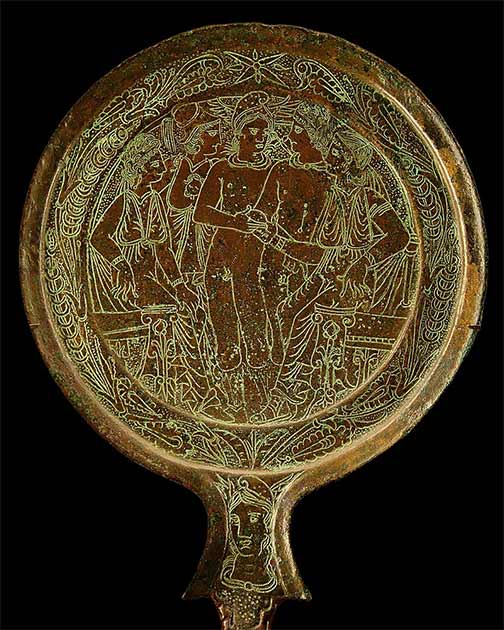Mirrors appear in a wide range of human cultures throughout history. The idea of an image somehow floating, disembodied and separate from the person looking — shining on a piece of polished stone or metal and reflecting the person’s body — certainly is beguiling. Literary and philosophical passages discussing mirrors are found in early Greek, Roman, Chinese, and other sources. Moreover, it is fascinating to note that even centuries ago, the fact that a mirror makes a reflected image led to the concept of a penetrating image — in fact, certain early Chinese sources present devices that are labeled as ‘mirrors’, but that have the power to see inside the human body. While these may be no more than technological speculations on the part of early thinkers, it is curious to see how such technologies are described. These early texts present an imaginative and prescient conception of a device that could function something like an X-ray, illuminating the organs inside a person.

Bronze mirror, New Kingdom of Egypt, Eighteenth Dynasty, (1540–1296 BC) Cleveland Museum of Art ( CC0)
Etymology Of Mirror
Throughout human history, human beings have made reflective devices from pieces of polished metal or metal and glass, in cultures in Europe, Asia, Africa, North America, and even remote Siberia. In Western culture, the word ‘mirror’ itself has a complex history. In English it appears in the early 13th century, coming from the Old French term mireor. That term came from the Latin verb mirari, meaning to wonder at, or admire. So, already in Latin, the words for the common mirror and for something special or magical were intertwined. Moreover, Latin had the word speculum, a general term for mirror, but also related to speculatio, a term which had a range of meanings including, watching, contemplation, and speculation. In ancient Greek, the term for mirror was κάτοπτρο and in the 17th century, this led to the peculiar English term ‘catoptromancy’, meaning divination by means of a mirror.
Both literary and archaeological evidence has revealed the existence of metal mirrors in antiquity, most often small, circular, hand-held items, with a highly polished mirrored surface on one side and a decorative scene on the reverse. Ancient sources even refer to ‘trick’ mirrors that yielded enlarged, diminished, or otherwise distorted images.

Etruscan mirror incised with the Judgement of Paris. (Fourth-third century BC) Musée du Louvre ( CC BY-SA 3.0)
Roman And Greek References
It is important to highlight the sophistication of ancient sources concerning this technology. One often thinks of earlier cultures as less in tune with the idea of machines, devices, and inventions.
Like this Preview and want to read on? You can! JOIN US THERE ( with easy, instant access ) and see what you’re missing!! All Premium articles are available in full, with immediate access.
For the price of a cup of coffee, you get this and all the other great benefits at Ancient Origins Premium. And – each time you support AO Premium, you support independent thought and writing.
Dr Benjamin B. Olshin is a former Professor of Philosophy, the History and Philosophy of Science and Technology, and Design at the University of the Arts in Philadelphia. His areas of expertise include sociology of science and technology, design, Eastern / Western philosophy, as well as cross-cultural management. His latest book is: Lost Knowledge: The Concept of Vanished Technologies and Other Human Histories .
Top Image : ‘Adorning Oneself’, detail from ‘Admonitions of the Instructress to the Palace Ladies’, Tang dynasty copy of an original by Chinese painter Gu Kaizhi, c. 344–405 AD ( Public Domain )
Related posts:
Views: 0
 RSS Feed
RSS Feed

















 February 25th, 2021
February 25th, 2021  Awake Goy
Awake Goy  Posted in
Posted in  Tags:
Tags: 
















